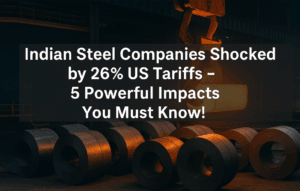Indian Steel Companies Shocked by 26% US Tariffs – 5 Powerful Impacts You Must Know!
Indian steel companies are currently assessing the potential impact of the 26% reciprocal tariffs announced by the United States. The move, aimed at countering what the US sees as high import duties imposed by India, is part of a broader effort by the US administration to reduce trade deficits and boost domestic manufacturing. While key sectors like steel, aluminium, and auto parts are already under earlier tariffs, the new measure raises concerns about shifting global trade flows. Experts warn that countries unable to export to the US might reroute their shipments to India, leading to a surge in cheaper imports.
Companies like Tata Steel and JSPL are reviewing the situation but have refrained from making immediate comments. Industry bodies fear that India may face steel dumping from nations like China, Japan, and South Korea. Despite the uncertainty, officials believe exports of specialized steel from India to the US may continue, as such products are not easily replaceable. The coming months will reveal how these tariffs reshape global and Indian steel trade dynamics.

Indian Steel Companies Shocked by 26% US Tariffs – 5 Powerful Impacts You Must Know!
Indian steel manufacturers are closely monitoring recent trade measures introduced by the United States, which could reshape global steel trade dynamics. The U.S. government has announced reciprocal tariffs targeting approximately 60 nations, including India, claiming these countries impose unfairly high duties on American goods. For India, this translates to a 26% tariff on select exports to the U.S.—a move aimed at reducing America’s trade deficit and boosting domestic production.
While the latest tariffs exclude steel, aluminum, automobiles, and auto parts—products already subject to earlier Section 232 tariffs (25% duty on steel since March 2018)—the industry remains cautious. Major Indian steel firms, including Tata Steel and Jindal Steel and Power Limited (JSPL), have adopted a wait-and-watch approach. Representatives from both companies stated they are analyzing the situation and will respond appropriately once more clarity emerges.
Global Trade Shifts and Risks for India
Experts warn that the U.S. decision could disrupt global steel trade patterns. Countries struggling to export steel to the U.S. due to higher tariffs might redirect surplus stock to alternative markets like India. This influx of cheaper steel could hurt local manufacturers by driving down prices and increasing competition. Rajamani Krishnamurti of the Indian Stainless Steel Development Association (ISSDA) highlighted the risk of “steel dumping,” where excess global supply floods the Indian market, undermining domestic producers.
Data from BigMint, a market research firm, underscores the potential scale of this shift. In 2024, the U.S. imported steel from several key suppliers:
- 3.06 million tonnes from the European Union (EU)
- 2.53 million tonnes from South Korea
- 1.19 million tonnes from Vietnam
- 0.75 million tonnes from Japan
- 0.39 million tonnes from China
- 0.22 million tonnes from India
Dhruv Goel, CEO of BigMint, suggested that even a partial diversion of these volumes to India could destabilize the local industry. For instance, if Chinese or EU steel exports to the U.S. drop, India might face heightened imports from these regions.
Specialized Exports May Remain Unaffected
Despite concerns, some industry leaders believe niche products could escape major disruptions. Amarendu Prakash, Chairman of Steel Authority of India Limited (SAIL), noted that the U.S. relies on imports for certain high-grade steel materials not produced domestically. These specialized items, such as alloys used in critical infrastructure or defense, may continue to be sourced from India, as establishing new manufacturing units for such products would be time-consuming and costly for the U.S.
Competition from Asian Producers
Analysts caution that India’s market could become a battleground for Asian steel exporters. Hridaya Mohan, a trade analyst, explained that if EU producers find U.S. tariffs unprofitable, they might lower prices to sell in India. Similarly, countries like South Korea, Japan, and China—already major exporters—could further increase shipments to India, squeezing profit margins for local companies. This scenario mirrors past challenges, such as in 2015–2016, when a surge in Chinese steel imports pressured Indian manufacturers.
Domestic Industry Calls for Vigilance
The Indian steel sector has urged the government to stay alert against unfair trade practices. Measures like anti-dumping duties and quality control standards, implemented in recent years to curb substandard imports, may need reinforcement. Krishnamurti emphasized the importance of monitoring import trends and acting swiftly if dumping occurs.
Balancing Exports and Domestic Needs
While safeguarding the home market is crucial, Indian exporters also seek to maintain their foothold in the U.S. for premium products. For example, India’s stainless steel and value-added steel products have niche demand in the U.S., and companies aim to protect these segments. However, broader uncertainties loom. The U.S.-India trade relationship, which saw tensions in 2018 over earlier tariffs, faces renewed strain. Both nations are expected to engage in negotiations to address trade imbalances, but outcomes remain uncertain.
Looking Ahead
The ripple effects of the U.S. tariffs will depend on how other nations respond. If trade barriers escalate globally, India’s steel industry could face dual pressures: defending its domestic market while navigating export challenges. For now, companies are prioritizing adaptability, exploring diversified markets, and investing in high-margin products to mitigate risks.
In summary, while the immediate impact of the U.S. tariffs on Indian steel remains unclear, the industry is bracing for potential turbulence. Strategic planning, government support, and agile responses will be key to weathering this storm and maintaining India’s position in the global steel landscape.
You must be logged in to post a comment.